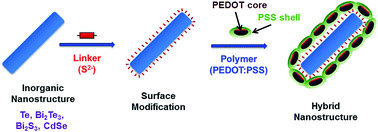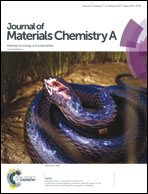Bottom-up design of de novo thermoelectric hybrid materials using chalcogenide resurfacing†
Abstract
Hybrid organic/inorganic thermoelectric materials based on conducting polymers and inorganic nanostructures have been demonstrated to combine both the inherently low thermal conductivity of the polymer and the superior charge transport properties (high power factors) of the inorganic component. While their performance today still lags behind that of conventional inorganic thermoelectric materials, solution-processable hybrids have made rapid progress and also offer unique advantages not available to conventional rigid inorganic thermoelectrics, namely: (1) low cost fabrication on rigid and flexible substrates, as well as (2) engineering complex conformal geometries for energy harvesting/cooling. While the number of reports of new classes of viable hybrid thermoelectric materials is growing, no group has reported a general approach for bottom-up design of both p- and n-type materials from one common base. Thus, unfortunately, the literature comprises mostly of disconnected discoveries, which limits development and calls for a first-principles approach for property manipulation analogous to doping in traditional semiconductor thermoelectrics. Here, molecular engineering at the organic/inorganic interface and simple processing techniques are combined to demonstrate a modular approach enabling de novo design of complex hybrid thermoelectric systems. We chemically modify the surfaces of inorganic nanostructures and graft conductive polymers to yield robust solution processable p- and n-type inorganic/organic hybrid nanostructures. Our new modular approach not only offers researchers new tools to perform true bottom-up design of thermoelectric hybrids, but also strong performance advantages as well due to the quality of the designed interfaces. For example, we obtain enhanced power factors in existing (by up to 500% in Te/PEDOT:PSS) and novel (Bi2S3/PEDOT:PSS) p-type systems, and also generate water-processable and air-stable high performing n-type hybrid systems (Bi2Te3/PEDOT:PSS), thus highlighting the potency of our ex situ strategy in opening up new material options for thermoelectric applications. This strategy establishes a unique platform with broad handles for custom tailoring of thermal and electrical properties through hybrid material tunability and enables independent control over inorganic material chemistry, nanostructure geometry, and organic material properties, thus providing a robust pathway to major performance enhancements.



 Please wait while we load your content...
Please wait while we load your content...